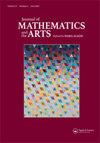Geometry: education, art, and research (GEAR 2021)
IF 0.2
Q4 MATHEMATICS, INTERDISCIPLINARY APPLICATIONS
引用次数: 0
Abstract
It is no exaggeration to say that Banff, Alberta, Canada is one of the most beautiful places on earth. The town sits within a Canadian national park and is surrounded by mountains on all sides. The slope of Tunnel Mountain is home to the Banff Centre for Arts and Creativity, a world-famous institute for visual, literary, and performing arts. And, in a stroke of good fortune that exceeds all expectations, the campus also hosts the Banff International Research Station (BIRS), a facility for research workshops in mathematics and related disciplines. I have attended a handful of events at BIRS over the years. I would take in the mountain vista from the dining hall, and look out the windows of lecture rooms to see deer grazing outside. After a day of mathematical discussion, I would often attend recitals by some of the young virtuosos studying at the Centre. All of this is to say that, amid all the chaos of the past twelve months, it was especially bittersweet to be invited to participate in an event hosted by BIRS, but not at BIRS. Overall I have appreciated the respite from work-related travel, but I would have liked a chance to visit Banff again. I was nevertheless delighted to have received an invitation to participate in the BIRS workshop entitled Geometry: Education, Art, and Research (GEAR 2021), held virtually over the weekend of February 19th, 2021. Targeted primarily at individuals in secondary and post-secondary education, the goal was to foster interaction between the three groups represented in the title (educators, artists, and researchers), on topics loosely related to geometry. If nothing else, it promised to be a good opportunity to connect with far-flung friends from the mathematical art world. And make no mistake: while the online format has unfortunate limitations that undermine the primary social goals of conferences, it also offers a few distinct advantages. First, it changes the pattern of attendance. A typical 2-day workshop at BIRS can host at most 25 participants. And while accommodations are provided, participants must cover their own travel and food costs. Attendance is therefore typically limited to academics with research support. GEAR 2021 brought together 66 confirmed participants, including a few artists who likely would not have been able to attend otherwise. The only real barrier to attendance would be too great a difference in time zones, given that the workshop operated on Mountain Time. See Figure 1 for a virtual group photo. Ther other advantage to meeting online is that, without much extra effort, the meeting can leave behind a large digital footprint. Most presentations were recorded, and几何学:教育、艺术与研究(GEAR 2021)
毫不夸张地说,加拿大阿尔伯塔省的班夫是地球上最美丽的地方之一。小镇坐落在加拿大国家公园内,四面环山。隧道山的斜坡是班夫艺术与创意中心的所在地,这是一个世界著名的视觉、文学和表演艺术研究所。而且,出乎所有人意料的幸运是,校园还拥有班夫国际研究站(BIRS),这是一个用于数学和相关学科研究研讨会的设施。这些年来,我参加了BIRS的一些活动。我会从餐厅眺望山景,从教室的窗户望出去,看到鹿在外面吃草。在进行了一天的数学讨论之后,我经常会去听一些在中心学习的年轻演奏家的独奏会。所有这一切都是说,在过去的12个月里,在所有的混乱中,被邀请参加由BIRS主办的活动尤其苦乐参半,但不是在BIRS。总的来说,我很感激从工作旅行中得到喘息的机会,但我希望有机会再次访问班夫。尽管如此,我还是很高兴地收到了参加BIRS研讨会的邀请,该研讨会名为“几何:教育,艺术和研究”(GEAR 2021),于2021年2月19日周末举行。主要针对中学和大专教育的个人,目标是促进标题中所代表的三个群体(教育家、艺术家和研究人员)之间在与几何松散相关的主题上的互动。如果没有别的,这将是一个与数学艺术界的远方朋友联系的好机会。不要搞错:虽然在线形式有一些不幸的限制,破坏了会议的主要社交目标,但它也提供了一些明显的优势。首先,它改变了出勤模式。在BIRS,一个典型的为期两天的研讨会最多可以容纳25名参与者。虽然提供住宿,但参与者必须支付自己的旅行和食品费用。因此,出席通常仅限于有研究支持的学者。GEAR 2021汇集了66位确认的参与者,其中包括一些可能无法参加的艺术家。考虑到研讨会在山地时间进行,唯一真正的障碍是时区差异太大。请参见图1中的虚拟集体照。在线会议的另一个好处是,不需要太多额外的努力,会议可以留下大量的数字足迹。大多数演讲都有录音,而且
本文章由计算机程序翻译,如有差异,请以英文原文为准。
求助全文
约1分钟内获得全文
求助全文
来源期刊

Journal of Mathematics and the Arts
MATHEMATICS, INTERDISCIPLINARY APPLICATIONS-
CiteScore
0.50
自引率
0.00%
发文量
19
 求助内容:
求助内容: 应助结果提醒方式:
应助结果提醒方式:


